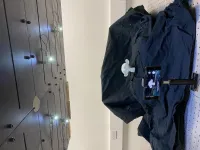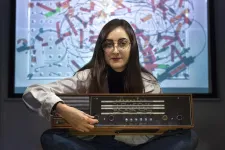(Press-News.org) WASHINGTON -- As LEDs replace traditional lighting systems, they bring more smart capabilities to everyday lighting. While you might use your smartphone to dim LED lighting at home, researchers have taken this further by tapping into dynamically controlled LEDs to create a simple illumination system for 3D imaging.
"Current video surveillance systems such as the ones used for public transport rely on cameras that provide only 2D information," said Emma Le Francois, a doctoral student in the research group led by Martin Dawson, Johannes Herrnsdorf and Michael Strain at the University of Strathclyde in the UK. "Our new approach could be used to illuminate different indoor areas to allow better surveillance with 3D images, create a smart work area in a factory, or to give robots a more complete sense of their environment."
In The Optical Society (OSA) journal Optics Express, the researchers demonstrate that 3D optical imaging can be performed with a cell phone and LEDs without requiring any complex manual processes to synchronize the camera with the lighting.
"Deploying a smart-illumination system in an indoor area allows any camera in the room to use the light and retrieve the 3D information from the surrounding environment," said Le Francois. "LEDs are being explored for a variety of different applications, such as optical communication, visible light positioning and imaging. One day the LED smart-lighting system used for lighting an indoor area might be used for all of these applications at the same time."
Illuminating from above
Human vision relies on the brain to reconstruct depth information when we view a scene from two slightly different directions with our two eyes. Depth information can also be acquired using a method called photometric stereo imaging in which one detector, or camera, is combined with illumination that comes from multiple directions. This lighting setup allows images to be recorded with different shadowing, which can then be used to reconstruct a 3D image.
Photometric stereo imaging traditionally requires four light sources, such as LEDs, which are deployed symmetrically around the viewing axis of a camera. In the new work, the researchers show that 3D images can also be reconstructed when objects are illuminated from the top down but imaged from the side. This setup allows overhead room lighting to be used for illumination.
In work supported under the UK's EPSRC 'Quantic' research program, the researchers developed algorithms that modulate each LED in a unique way. This acts like a fingerprint that allows the camera to determine which LED generated which image to facilitate the 3D reconstruction. The new modulation approach also carries its own clock signal so that the image acquisition can be self-synchronized with the LEDs by simply using the camera to passively detect the LED clock signal.
"We wanted to make photometric stereo imaging more easily deployable by removing the link between the light sources and the camera," said Le Francois. "To our knowledge, we are the first to demonstrate a top-down illumination system with a side image acquisition where the modulation of the light is self-synchronized with the camera."
3D imaging with a smartphone
To demonstrate this new approach, the researchers used their modulation scheme with a photometric stereo setup based on commercially available LEDs. A simple Arduino board provided the electronic control for the LEDs. Images were captured using the high-speed video mode of a smartphone. They imaged a 48-millimeter-tall figurine that they 3D printed with a matte material to avoid any shiny surfaces that might complicate imaging.
After identifying the best position for the LEDs and the smartphone, the researchers achieved a reconstruction error of just 2.6 millimeters for the figurine when imaged from 42 centimeters away. This error rate shows that the quality of the reconstruction was comparable to that of other photometric stereo imaging approaches. They were also able to reconstruct images of a moving object and showed that the method is not affected by ambient light.
In the current system, the image reconstruction takes a few minutes on a laptop. To make the system practical, the researchers are working to decrease the computational time to just a few seconds by incorporating a deep-learning neural network that would learn to reconstruct the shape of the object from the raw image data.
INFORMATION:
Paper: E. Le Francois, J. Herrnsdorf, J. J. D. McKendry, L. Broadbent, G. Wright, M. D. Dawson, M. J. Strain, Synchronization-free top-down illumination photometric stereo imaging using light-emitting diodes and a mobile device, Opt. Express, 29, 2, 1502-1515 (2021).
DOI: https://doi.org/10.1364/OE.408658.
About Optics Express
Optics Express reports on scientific and technology innovations in all aspects of optics and photonics. The bi-weekly journal provides rapid publication of original, peer-reviewed papers. It is published by The Optical Society (OSA) and led by Editor-in-Chief James Leger of the University of Minnesota, USA. Optics Express is an open-access journal and is available at no cost to readers online at OSA Publishing.
About The Optical Society
Founded in 1916, The Optical Society (OSA) is the leading professional organization for scientists, engineers, students and business leaders who fuel discoveries, shape real-life applications and accelerate achievements in the science of light. Through world-renowned publications, meetings and membership initiatives, OSA provides quality research, inspired interactions and dedicated resources for its extensive global network of optics and photonics experts. For more information, visit osa.org.
Media Contact:
mediarelations@osa.org
BUFFALO, N.Y. -- Scientists have known for years that mutations in the MLL4 gene can cause Kabuki syndrome, a rare developmental disorder.
But a study published on Jan. 11 in Nature Communications illuminates new details regarding how this occurs. (Images are available by contacting Charlotte Hsu in UB Media Relations at chsu22@buffalo.edu.)
The research suggests that MLL4 controls the production of neurons that secrete growth hormone-releasing hormone (GHRH) in a part of the brain called the hypothalamus. Mice without working copies of the MLL4 gene in this area had stunted growth and markedly fewer GHRH neurons. Mice with only one functioning ...
CLEVELAND - As reported in Nature Communications, researchers from Cleveland Clinic's Lerner Research Institute have developed a novel, patient-derived model of ulcerative colitis, which will help advance studies into new treatments for the chronic inflammatory bowel disease.
The team used the model to identify a promising target that could be inhibited to slow disease progression.
Ulcerative colitis is characterized by abnormal reactions of the immune system that lead to inflammation and ulcers on the inner lining of the large intestines. It is a highly heterogeneous condition, both in terms of patients' symptoms and disease pathology.
Suppressing the overactive immune response with anti-inflammatory drugs is the current ...
Use of telehealth jumped sharply during the first months of the coronavirus pandemic shutdown, with the approach being used more often for behavioral health services than for medical care, according to a new RAND Corporation study.
Between mid-March and early May 2020, telehealth was used by more than 40% of patients with a chronic physical health condition and by more than 50% of those with a behavioral health condition, according to findings published in the Journal of General Internal Medicine.
Overall, almost half of the people who were undergoing treatment when the pandemic shutdown ...
In countries with a severe shortage of surgeons it is common for some operations to be carried out by medical staff with lower formal qualifications. Researchers at Karolinska Institutet, Sweden, have led an international study on the safety and efficacy of a common surgical procedure. The study, published in
JAMA Network Open, shows that inguinal hernia operations performed by associate clinicians at a hospital in Sierra Leone were just as safe and effective as those performed by doctors.
Many Sub-Saharan countries have a desperate shortage of surgeons, and to ensure that as many patients as possible can be treated, some operations are carried out by medical professionals who are not specialists in surgery. Such task sharing is supported by several bodies, including the World Health ...
Would you like to capture a chemical transformation inside a cell live? Or maybe revolutionize microchips' production by printing paths in a layer that has a thickness of just 100 nanometers? These and many other goals can now be achieved with the latest femtosecond laser created by a team of scientists led by Dr. Yuriy Stepanenko.
These days, there is a multitude of laser light sources. They each have their characteristics and different applications, such as observing stars, treating illnesses, and surface micro-machining. "Our goal is to develop new ones," says Yuriy Stepanenko, head of the team of Ultrafast Laser Techniques at the Institute of Physical Chemistry of the Polish Academy of Sciences. "We deal with sources that produce ultrashort pulses of light. Really very, ...
The study found a "systematic and quantifiable pattern" of political parties officers opting against fielding minority candidates where they perceive that their non-white appearance might prevent a win. This includes constituencies already held by the party, and those within reach, requiring just a small swing in the vote to change hands.
Dr Patrick English, from the University of Exeter, who carried out the research, said: "This combination of public opinion and party strategy is one of the most significant blockages to electing parliaments which fully reflect ...
A team of researchers from Colorado State University and the University of Cincinnati have discovered a new mode of snake locomotion that allows the brown tree snake to ascend much larger smooth cylinders than any previously known behavior.
This lasso locomotion, named because of a lasso-like body posture, may contribute to the success and impact of this highly invasive species. It allows these animals to access potential prey that might otherwise be unobtainable and may also explain how this species could climb power poles, leading to electrical outages.
Researchers said they hope the findings will help people protect endangered birds from the snakes.
The ...
Researchers reporting in Current Biology on January 11 have discovered that invasive brown tree snakes living on Guam can get around in a way that had never been seen before. The discovery of the snake's lasso-like locomotion for climbing their way up smooth vertical cylinders has important implications, both for understanding the snakes and for conservation practices aimed at protecting birds from them.
"Our most important finding is a new mode of snake locomotion," says co-senior author Julie Savidge of Colorado State University (CSU). "Only four major types have been recognized for nearly 100 ...
What The Study Did: Researchers examined pediatric COVID-19 hospitalization trends in 22 states for both severity among this population and spread of the virus.
Authors: Pinar Karaca-Mandic, Ph.D., of the University of Minnesota Carlson School of Management in Minneapolis, is the corresponding author.
To access the embargoed study: Visit our For The Media website at this link https://media.jamanetwork.com/
(doi:10.1001/jamapediatrics.2020.5535)
Editor's Note: The article includes conflict of interest and funding/support disclosures. Please see the article for additional information, including ...
What The Study Did: Medical records for patients admitted to an urban academic medical center were analyzed for race and ethnicity for evidence of racial bias in clinician documentation.
Authors: Jessica R. Balderston, M.D., of Virginia Commonwealth University Medical Center in Richmond, is the corresponding author.
To access the embargoed study: Visit our For The Media website at this link https://media.jamanetwork.com/
(doi:10.1001/jamainternmed.2020.5792)
Editor's Note: The article includes conflicts of interest disclosures. Please see the article for additional information, including other authors, author contributions and affiliations, conflict of interest ...



